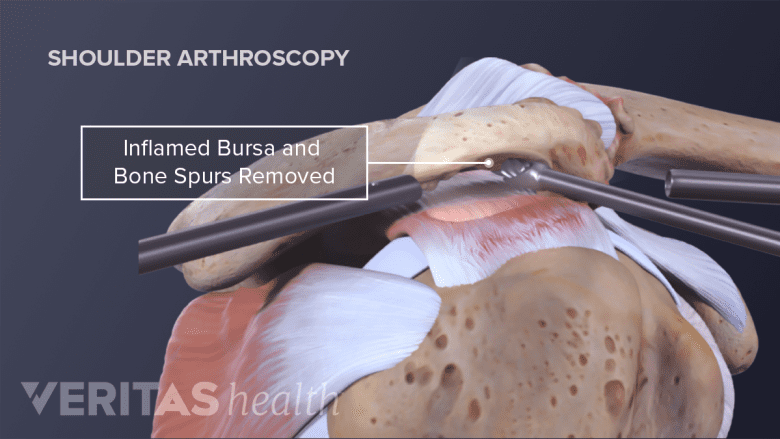While most cases of shoulder impingement can be treated without surgery, sometimes it is recommended. A doctor may suggest surgery if nonsurgical treatment options do not adequately relieve shoulder pain and improve range of motion.

Arthroscopic shoulder surgery involves the repair or reconstruction of damaged tissues through small incisions.
In This Article:
- Shoulder Pain: Is it Shoulder Impingement?
- Shoulder Impingement Symptoms
- Causes and Risk Factors of Shoulder Impingement
- Diagnosing Shoulder Impingement
- Nonsurgical Treatments for Shoulder Impingement
- Surgical Treatment Options for Shoulder Impingement
Surgery can create more room for the soft tissues that are being squeezed. Surgical treatment for shoulder impingement may include:
Subacromial decompression and acromioplasty. During decompression surgery, a surgeon removes bone tissue from the end and underside of the acromion, the topmost bone of the shoulder. This procedure expands the subacromial space, which is located between the acromion and the shoulder’s ball-and-socket joint. Expanding this space creates more room for tendons and other soft tissues. People with curved or hooked acromions or significant subacromial bone spurs may be candidates for this procedure.
- Bursectomy. This is a procedure that will remove an inflamed bursa and any surrounding scar tissue. After removal, a new bursa may grow in its place.
Rotator cuff repair. A rotator cuff repair may involve reattaching torn tendons to their attachment site on the upper humerus bone.
Subacromial decompression, shoulder bursectomy, and rotator cuff repairs can be performed in two different ways:
- Arthroscopic technique. This is a minimally invasive surgery that is performed using small tools inserted into multiple small incisions around the shoulder area. The doctor is able to see into the area with an arthroscope, a device about the size of a pencil that is equipped with a small television camera.
- Open technique. This approach requires an incision, usually no more than 3 inches in length, so that the surgeon can directly view the rotator cuff and acromion.
See Shoulder Decompression: Arthroscopy vs Open Surgery
The type of surgery performed will be dependent upon the doctor’s preference as well as the severity of the injury and any underlying structural conditions. Arthroscopic surgery is most common.
Recovering from Shoulder Surgery
Recovery and long-term effects from these shoulder surgeries is dependent upon a number of factors, including the type of surgery (open or arthroscopic) and the patient’s age.
See Shoulder Decompression Surgery: Recovery, Risks, and Complications
Generally, a person’s arm will be placed in a sling for 1 to 2 weeks to limit mobility so that the shoulder can start to heal. A graduated rehabilitation program is then started depending on the surgical procedure. These typically begin with stretches to recover range of motion and eventually incorporate strengthening exercises.
Most people are able to return to the activities they did before surgery in about 2 to 4 months. In some cases, full recovery can take up to a year.

